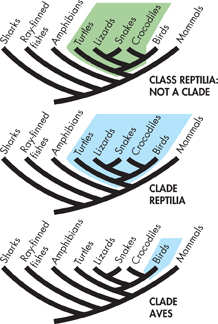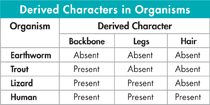Clades and Traditional Taxonomic Groups Which of the Linnaean groupings form clades, and which do not? Remember that a true clade must be monophyletic, which means that it contains an ancestral species and all of its descendants—it can't leave any out. It also cannot include any species which are not descendants of that original ancestor. Cladistic analysis shows that many traditional taxonomic groups do form valid clades. For example, Linnaean class Mammalia corresponds to clade Mammalia (shown in Figure 18–9). Members of this clade include all vertebrates with hair and several other important characteristics.

FIGURE 18–10 Clade or Not? A clade includes an ancestral species and all its descendants. Linnaean class Reptilia is not a clade because it does not include modern birds. Because it leaves this descendant group out, the class is paraphyletic. Clades Reptilia and Aves, however, are monophyletic and, therefore, valid clades. Apply Concepts Would a group that included all of clade Reptilia plus amphibians be monophyletic or paraphyletic? Explain.
dIn other cases, however, traditional groups do not form valid clades. Figure 18–10 shows why. Today's reptiles are all descended from a common ancestor. But birds, which have traditionally not been considered part of the Linnaean class Reptilia, are also descended from that same ancestor. So, class Reptilia, without birds, is not a clade. However, several valid clades do include birds: Aves (the birds themselves), Dinosauria, and the clade named Reptilia. So, is it correct to call birds reptiles? An evolutionary biologist would say yes!
You may be wondering: class Reptilia, clade Reptilia, who cares? But the resulting names aren't as important as the concepts behind the classification. Evolutionary biologists look for links between groups, figuring out how each is related to others. So the next time you see a bird, thinking of it as a member of a clade or class isn't as important as thinking about it not just as a bird, but also as a dinosaur, a reptile, a tetrapod, and a chordate.
Quick Lab
GUIDED INQUIRY
Constructing a Cladogram
Identify the organism in the table that is least closely related to the others.
-
Use the information in the table to construct a cladogram of these animals.
Interpret Tables What trait separates the least closely related animal from the other animals?
Apply Concepts Do you have enough information to determine where a frog should be placed on the cladogram? Explain your answer.
Draw Conclusions Does your cladogram indicate that lizards and humans share a more recent common ancestor than either does with an earthworm? Explain your answer.
Analyze and Conclude
Table of Contents
- Formulas and Equations
- Applying Formulas and Equations
- Mean, Median, and Mode
- Estimation
- Using Measurements in Calculations
- Effects of Measurement Errors
- Accuracy
- Precision
- Comparing Accuracy and Precision
- Significant Figures
- Calculating With Significant Figures
- Scientific Notation
- Calculating With Scientific Notation
- Dimensional Analysis
- Applying Dimensional Analysis





